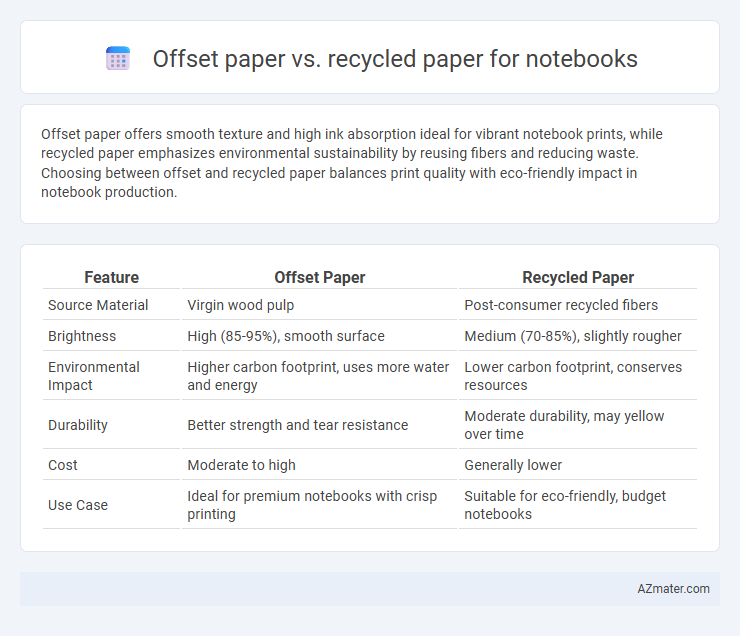Offset paper offers smooth texture and high ink absorption ideal for vibrant notebook prints, while recycled paper emphasizes environmental sustainability by reusing fibers and reducing waste. Choosing between offset and recycled paper balances print quality with eco-friendly impact in notebook production.
Table of Comparison
| Feature | Offset Paper | Recycled Paper |
|---|---|---|
| Source Material | Virgin wood pulp | Post-consumer recycled fibers |
| Brightness | High (85-95%), smooth surface | Medium (70-85%), slightly rougher |
| Environmental Impact | Higher carbon footprint, uses more water and energy | Lower carbon footprint, conserves resources |
| Durability | Better strength and tear resistance | Moderate durability, may yellow over time |
| Cost | Moderate to high | Generally lower |
| Use Case | Ideal for premium notebooks with crisp printing | Suitable for eco-friendly, budget notebooks |
Introduction: Understanding Notebook Paper Types
Offset paper, known for its smooth texture and high opacity, is commonly used in notebooks for its excellent print quality and durability. Recycled paper, made from reclaimed fibers, offers an eco-friendly alternative with slightly lower brightness and strength but reduces environmental impact significantly. Choosing between offset and recycled paper depends on balancing print clarity and sustainability priorities in notebook production.
What is Offset Paper?
Offset paper, commonly used in high-quality notebook production, is designed for smooth printing and sharp image reproduction, composed primarily of virgin wood pulp for consistent texture and brightness. This type of paper boasts excellent ink absorption and minimal bleeding, making it ideal for detailed printing in offset lithography processes. Compared to recycled paper, offset paper typically offers greater durability and a cleaner surface, enhancing the overall writing and visual experience in notebooks.
What is Recycled Paper?
Recycled paper for notebooks is made from post-consumer waste or industrial scraps that are reprocessed to create new sheets, significantly reducing the demand for virgin wood fibers. This sustainable alternative minimizes environmental impact by conserving natural resources, lowering energy consumption, and reducing landfill waste compared to offset paper, which is produced from fresh pulp. Using recycled paper in notebooks supports eco-friendly manufacturing practices and promotes a circular economy within the paper industry.
Manufacturing Process: Offset vs Recycled Paper
Offset paper manufacturing involves wood pulp that is chemically or mechanically processed to create smooth, bright, and uniform sheets ideal for high-quality printing in notebooks. In contrast, recycled paper production repurposes post-consumer or post-industrial fiber waste, undergoing processes like deinking and re-pulping to reduce environmental impact while often resulting in a rougher texture and lower brightness. The offset paper process typically demands more virgin fiber and energy, whereas recycled paper manufacturing emphasizes resource conservation and sustainability throughout the production chain.
Environmental Impact Comparison
Offset paper production generates higher carbon emissions and consumes more water compared to recycled paper, contributing significantly to deforestation and resource depletion. Recycled paper for notebooks reduces landfill waste, lowers energy consumption by up to 60%, and minimizes greenhouse gas emissions, making it a more sustainable choice. Selecting recycled paper supports circular economy practices and reduces the environmental footprint associated with paper manufacturing.
Print Quality and Writing Experience
Offset paper offers superior print quality with sharp, vibrant images and crisp text, making it ideal for notebooks requiring high-resolution graphics. Its smooth texture enhances the writing experience by preventing ink bleed-through and allowing for clean, precise handwriting. Recycled paper often has a rougher surface and less consistent texture, which can result in slightly lower print clarity and a more absorbent feel that may cause smudging with certain inks.
Durability and Longevity
Offset paper for notebooks offers superior durability and smoother texture, making it ideal for frequent writing and long-term use due to its high-quality wood pulp composition. Recycled paper, while environmentally friendly, tends to have shorter longevity and may exhibit more wear and tear because of the lower fiber strength from processed waste materials. Choosing offset paper enhances notebook lifespan, whereas recycled paper provides eco-conscious benefits with modest durability trade-offs.
Cost Analysis: Offset vs Recycled Paper
Offset paper generally offers lower production costs due to its widespread availability and standardized manufacturing processes, making it a cost-effective choice for high-volume notebook printing. Recycled paper, while often pricier because of the additional processing needed to repurpose fibers, provides environmental benefits that can justify the higher expense for eco-conscious consumers. Evaluating the total cost impact involves balancing initial material costs with potential brand value enhancement and consumer preference for sustainability.
Choosing the Right Paper for Your Needs
Selecting the right paper for your notebook depends on usage and environmental priorities. Offset paper offers smooth writing and vibrant printing, ideal for professional or artistic notebooks, while recycled paper supports sustainability with eco-friendly materials and reduces waste. Evaluate your preference for print quality versus environmental impact to make an informed choice between offset and recycled paper.
Conclusion: Which is Better for Notebooks?
Offset paper offers superior smoothness and print clarity, making it ideal for high-quality notebooks with vibrant designs and fine details. Recycled paper provides an eco-friendly choice by reducing environmental impact without significantly compromising durability and comfort for everyday writing. Choosing between the two depends on prioritizing either print excellence with offset paper or environmental sustainability with recycled paper for notebook production.

Infographic: Offset paper vs Recycled paper for Notebook
 azmater.com
azmater.com